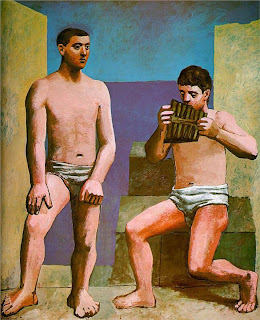Recently, we've been talking about shape, another basic element of the visual language.
We've been doing some activities about shape, paying special attention at edge, outline and inside contour line.
The last work we're going to do is a Cubist Collage using a Picasso's artwork, "Three musicians", as a model.
In this artwork, Picasso didn't use the collage technique, but he painted in Cubist Style and gave the appearence of cut paper.
CUBISM
Do you know who the Cubists were?
Cubism was a truly revolutionary style of modern art
developed by Pablo Picasso and Georges Braque. It was the first style
of abstract art which evolved at the beginning of the 20th century in
response to a world that was changing very quickly.
Cubist Artists tried to change conventional forms of representation, such as perspective. Their aim was to develop a new way of seeing which reflected the modern age.
The Cubists introduced collage into painting, and they were influenced by art from other cultures, specially African Masks.
Another important Cubist Artist was Juan Gris.
 |
| Pablo Picasso - Horta de Sant Joan (oil on canvas, 1909) |
 |
| Georges Braque - Landscape in l'Estaque (oil on canvas, 1908) |
 |
| Juan Gris - Le Canigou (oil on canvas, 1921) |
Try to learn more about Cubism in Artyfactory.com
You can also test your knowledges about Cubism here.
COLLAGE
Collage is an art technique where the artwork is made from an assemblage of different forms, thus creating a new whole.
Collage can include different materials as newspapers, coloured papers, photographs, texts, and also fabric or any kind of object, all them glued to a piece of paper or canvas.
The word "collage" means "to glue" ("coller" in French means "glue"), and was invented by George Braques and Pablo Picasso in the beginning of the 20th Century. It became an important part of Modern Art.
I'm sure you've done a lot of collage artworks at school, haven't you?
Ok, we can start our work watching the next video (in Spanish):
And we can practise online collage using these multimedia aplications:
- Collage machine 1.0
- Collage machine: you need the Shockwave plug-in.
- Remix, an interactive collage (MOMA)
- Collage Maker: faces collage
PABLO RUIZ PICASSO
It's time to talk about one of the most important artist in Art History. He was a Spanish painter, he was born in Malaga in 1881 and his name was Pablo Ruiz Picasso.
As you've read above, he was one of the first Cubists, and he also developed collage techniques.
His Artwork includes different Art Periods:
 |
| Picasso - The Pan Pipes (1923) |
- Early times (before 1901)
- Blue Period
- Rose Period
- African-influenced Period
- Cubism
- Classicism and Surrealism
- Later works
Can you find an example of any Period in the Internet? Paste the pictures into a powerpoint . It should show the next information:
1st slide: Tittle: Picasso's Art Periods. Autor (your name)
2nd slide: Tittle: Early times. Image: a picture from Picasso's early times artwork. Under the picture, write the name of the artwork.
3rd slide: Tittle: Blue Period. Image: a picture from Picasso's Blue Period artwork. Under the picture, write the name of the artwork.
And continue until Later works.
You can find more information here: www.pablopicasso.org
When finished, send your powerpoint to Evip's e-mail.
An amazing game: try to build a Picasso Puzzle of one of his most famous paintings: Guernica.
AND AT LAST BUT NOT AT LEAST...
As I told, we're going to reproduce Picasso's Artwork "The three musicians" using the collage technique.
You will need:- An A3 cardboard (where the collage will be glued)
- Coloured paper (cardboard, silk paper, tissue paper, wrapping paper...)
- Newspapers
- Pictures
- Scissors
- Glue
- Wax crayons

